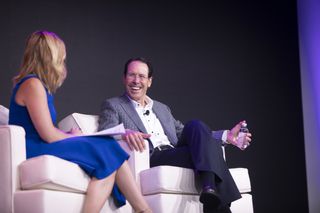AT&T Xandr Launches With Mandate To Change the Advertising Business
SANTA BARBARA, Calif. — AT&T, founded by telephone inventor Alexander Graham Bell, has unveiled Xandr, a company that seeks to reinvent advertising.
At what it called a Relevance Conference here, former media agency executive Brian Lesser, now CEO of Xandr, described the company’s ambition to make advertising matter again.

“If all we do is improve advertising as it exists today, then we at [Xandr] will have failed miserably,” Lesser said.
To some degree, the event was a pep rally for the new AT&T unit. It was also a forum for discussing what ails the ad business.
Message Addressed Across Media
Guests included executives from media agencies, ad tech companies and other media firms, including representatives of NBCUniversal, Fox, CBS and Viacom.
Along with Turner — part of AT&T since the acquisition of parent company Time Warner (since renamed WarnerMedia) — NBC and Viacom have been leaders in talking about changing TV advertising by using better targeting to enable them to raise the value of their commercial inventory and improve the consumer experience of ad-supported TV by reducing commercial clutter.
Multichannel Newsletter
The smarter way to stay on top of the multichannel video marketplace. Sign up below.
An executive from one media company praised the way Xandr was introduced with great ambition but no exaggerated claims about its current capabilities. What AT&T was aiming to do wouldn’t be easy but perhaps, with AT&T throwing its assets into the effort and collaborating with others in the industry, the transition to a new approach to TV advertising would happen faster and be more successful.
In his speech introducing the name Xandr, Lesser said that “if you think about the advertising marketplace right now, everybody’s frustrated.”
Lesser said advertisers are under pressure to justify how they’re spending their marketing dollars and demonstrate return on investment. They also want more choices for how they reach their consumers, he said.
AT&T is uniquely positioned to create that marketplace because of the assets it has in content, distribution (notably DirecTV), data and technology, Lesser said.
“Using those four assets, we can improve advertising for consumers,” he said. “We can develop innovation where advertising isn’t a traditional commercial break but becomes an interactive experience tied directly to commerce.”
Two outside partners — cable company Altice USA and telco Frontier Communications — have already signed on to have Xandr sell addressable inventory for them (see Platforms).
To a degree, those seeking to reinvent TV advertising want it to be more like digital advertising.
Some TV executives at the event thought AT&T chairman and CEO Randall Stephenson went too far in that direction during an interview at the conference.
“I think advertising is really, really smart in half the world,” Stephenson said. “The digital half is really good. The digital half is very targeted. The digital half, if if you’re an advertiser, you’re getting good feedback. You’re getting the ability to manage campaigns and to deliver ads on your own without a lot of human intervention.”
TV is a very different world, he told CNN’s Poppy Harlow, who conducted the interview. “If you look at the side of the world where you operate, the premium video original TV business, it looks nothing like that,” Stephenson said. “And the advertising is not terribly targeted. The advertising does require a lot of human intervention. We’re still selling the lion’s share of the advertising in upfronts and so forth.”
Stephenson said the TV was among the most averse-to-change businesses.
“We actually believe that if you can make the premium video side behave, look, operate like the digital side that people will invest more and that people will be excited about the advertising model on that side,” he said.
Not everyone shared Stephenson’s rave for digital advertising.
Forrester Research vice president and principal analyst Joanna O’Connell presented a study that showed digital advertising was even more disliked than TV advertising and that some attempts at targeting backfired by making consumers angry about the way their data was being used and personalization easily turned creepy.
Cracking the Attribution Code
Nevertheless, Lesser and Xandr could be making steps in the right direction.
“I think we need a better mousetrap,” said John Swift, CEO of investment and integrated services, North America, at Omnicom Media Group, speaking on a panel about addressable advertising.
“We’re in a spot where we don’t have the right measurement, we haven’t figured out how to bring video across different devices and screens, we haven’t cracked the code of attribution,” Swift said.
“The good news is, I like what AT&T is doing, and I’m not just saying that because [AT&T] is my biggest client,” he said, referring to its plan to connect with by having distribution, content and technology.
“You guys are probably the second company that aligns some of those things, but you’re the first one that actually has a path to get there,” Swift said.
On the same panel, Nick Brien, CEO for the Americas at Dentsu Aegis Network, said the kind of addressable advertising Xandr planned to provide is useful. “It plays a most significant part of our desire to execute with ruthless efficiency,” he said.
Jon has been business editor of Broadcasting+Cable since 2010. He focuses on revenue-generating activities, including advertising and distribution, as well as executive intrigue and merger and acquisition activity. Just about any story is fair game, if a dollar sign can make its way into the article. Before B+C, Jon covered the industry for TVWeek, Cable World, Electronic Media, Advertising Age and The New York Post. A native New Yorker, Jon is hiding in plain sight in the suburbs of Chicago.










